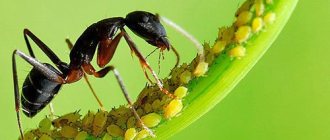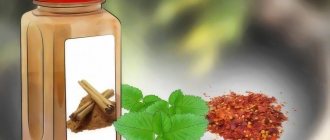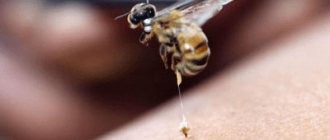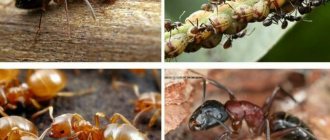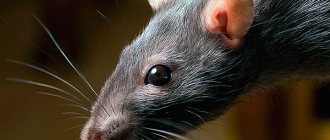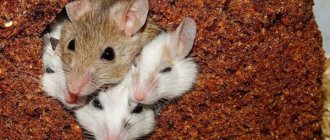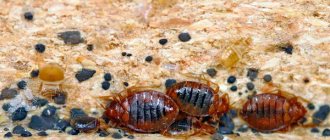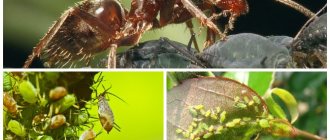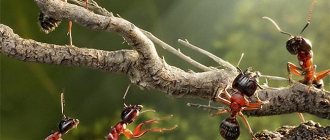In the Central region of Russia, problems in a garden, apartment or room are usually caused by black, red, red-breasted or house ants. Each of these species has its own favorite habitats.
- Red and red-breasted ants can make anthills directly in the structure of a house or other building, inside furniture.
- House ants and black ants prefer to live outside and enter indoors only in search of food or during migration, when the colony moves in an organized formation in one specific direction.
All these types of ants have a similar anatomical structure and sensory organs, so you can fight them using the same methods. What are ants afraid of? What means can be used to combat them?
Folk remedies
Folk remedies in the fight against ants work with varying success - what helps some people proves to be absolutely useless for others. Because of this, choosing an effective folk or natural remedy can only be done by trial and error, tracking changes after the introduction of each new method.
Pepper
Where to use:
garden
Using ground black or red cayenne pepper, you can create protective boundaries against ants by sprinkling it along garden paths or in areas where ants gather. This method is not very convenient for indoor use - the pepper will fly apart in a draft and create excess dirt.
Salt
Where to use:
house/garden
A strong solution of a whole pack of diluted salt with 5 liters of warm water can be poured directly into the anthill, or salt can be sprinkled in a dense layer in places from which you want to repel pests. In high concentrations, salt can damage the chitinous coverings of ants. In an apartment or house, salt can be poured in a uniform layer between double window frames.
Soda
Where to use:
garden
A solution of soda and water at the rate of 3 tablespoons per 1 liter of liquid is poured into an anthill in the garden. After this, the top layer of soil above it is additionally sprinkled with dry powder from the pack.
Soap
Where to use:
garden
against aphids is prepared based on soap with or without the addition of dishwashing liquid.
, which is grown by ants, as well as a means for filling the entire anthill. To spray plants, a lower concentration is required - 2 doses of soap and/or dish gel per 0.5-1 liter of water. To fill the anthill, you can use 2-4 doses of pressing the dispenser per 1 liter of water.
Boiling water
Where to use:
garden
Boiling water is used only against garden ants, pouring it into the anthill from a kettle. Water must be poured slowly so that it flows into the passages and is absorbed into the soil, and does not spill from above like a puddle. To achieve a visible effect, you will need several kettles of water. If the pests restore the anthill in its original place, fill in more water next time.
Helpful advice
To destroy an anthill, you can try using regular water from a hose.
To do this, you need to make a small hole in the center of the anthill, insert a hose into it, fix it in a vertical position with soil and stones and turn on the water. Leave the hose turned on at medium pressure for 5-10 minutes. If the water completely floods the anthill and the queen dies in it, consider that the problem is solved. Boric acid
Where to use:
garden
Baiting ants with boric acid is one of the most effective folk methods, but it involves the use of poison. By placing such baits in the garden, you can accidentally poison birds and animals that you did not plan to get rid of.
To make baits with boric acid, poison and some food, preferably with sugar, are used in proportions of 2/1. You can mix with boric acid:
- Honey
- Jam
- Thick jam
- Chopped meat
- Hard boiled egg
- Sugar and water
The result should be a plastic mass, small pieces of which should be laid out near the anthill or placed in the lids of 5-liter canisters. The ants will eat the poison and take it to the anthill to feed the larvae and their queen. As soon as the queen eats enough bait flavored with boric acid, she will die, the anthill will become disorganized and disappear.
Ash
Where to use:
garden
The chemical composition of ash can cause damage to the integrity of the ants' cover, so they tend to avoid contact with it. You can sprinkle ash on top of the ants' nest, loosen it a little and pour plenty of water on it.
Corn flour
Where to use:
garden
Most food ingredients are used to create baits, but some products can be harmful to the digestion of pests. Similar hypotheses exist about millet, but in solid form it is ineffective. The situation is different with cornmeal. You need to sprinkle the top layer of the anthill with it, lightly spilling the scattered flour with water to make it easier for the ants to eat it. If the ants do not moderate their appetites, a large amount of flour eaten can harm their digestion. No matter how strange it may sound in relation to insects, the result largely depends on the intelligence of the ants. In any case, if you definitely want to use some folk remedies, you can try this option.
Red hot pepper (Capsicum annuum)
Red hot peppers may provide some protection against ants, since these insects find the chemical irritant capsaicin not particularly attractive. However, since it is only present in the fruit and not the foliage of peppers, these plants will likely not have any protective properties until the fruits appear.
What plants are ants afraid of?
Some flowers and culinary herbs can be used to repel ants. All flowers that contain natural pyrethrum, a natural insecticide, are especially effective. What plants are ants afraid of among those that can be planted in open ground and in pots in our climate? These include:
- Peppermint
- Lavender
- Rosemary
- Thyme
- Tansy
- Yarrow
- Marigold
- Garlic
In the garden, they can be planted directly in the beds or as part of decorative plantings in sunny open areas - it is in such places that ants most often make their nests. Fragrant herbs can also be planted in pots and moved around the site or house to those places where there is a need to repel ants.
Coffee beans and coffee grounds
Ants don't like the smell of coffee, but they don't mind coffee. If you place coffee as an obstacle, the ants will avoid it at first, but then remove it (coffee beans) or cover it with sand if it is ground.
What smell are ants afraid of?
Ants have an exceptionally developed olfactory system, which allows them to find food at large distances from themselves and navigate in space. This sensitivity to odors can be used against insects. What smell are ants afraid of?
Citrus
Where to use:
house/garden
Any strong enough citrus scent will literally overpower most other odors for ants, making them feel uncomfortable. You can spread the peels of oranges, lemons and grapefruits around the area and in the house, or prepare a homogeneous paste from one of the above fruits in a blender and place it in places where you need to repel pests, for example, in the kitchen. To give it a thicker consistency, you can add flour or starch to the ground citrus fruits.
Cinnamon
Where to use:
house/garden
Cinnamon sticks can be placed around the house as an insect repellent. In the garden, it is preferable to use ground cinnamon, sprinkling it on places where you want to repel ants. Ground cinnamon is especially effective for protecting compost heaps from ant attacks. Sprinkle a few packets of ground spice into the pile every month.
Neem oil
Where to use:
house/garden
Neem oil is used mainly in cosmetology, but it is also an effective remedy against more than two hundred species of insects. It will not be possible to completely saturate an anthill with it, but by adding oil to water and treating plants and surfaces with this solution, you can not only repel pests, but also destroy those individuals that came into contact with the composition. Neem oil is also good for aphids. It is necessary to mix it with 1 liter of water in a proportion starting from 10 drops, gradually increasing the concentration if necessary.
You can use any recommended scents from their natural source or in the form of essential oils. The second option is sometimes even more effective.
Vinegar
Where to use:
house/garden
Vinegar can be used against both house and garden ants. In the garden, a liter bottle of vinegar must be poured entirely into the nest. Indoors, a solution of 2 tablespoons of vinegar and half a liter of water is sprayed and wiped all surfaces with which pests may come into contact. Vinegar is more effective than other means in destroying pheromones that ants leave behind as trail markers. This helps to avoid a massive invasion of pests after the first scouts appear - other individuals will not be able to find their way to food following the traces left by their predecessors.
Rodents
Like ants, mice colonize by following pheromones emitted by others, so interrupting this process with a strong scented oil can prevent them from spreading throughout your home.
Apply peppermint oil around the entry points where you notice them. You can also put a cotton swab with a small amount of tea tree oil. If you put a few drops of peppermint oil in a garbage bag or at the bottom of a bucket, you will send rats looking for dinner elsewhere.
Found a violation? Report content
What are ants afraid of at home: how to get rid of them
If the fight against these insects in the garden can be carried out more or less without haste, then when ants appear in the house, there is not much time left to think and sort through options, especially if the pests invade you en masse.
You can try using the products that ants are afraid of at home from the list above, but the most effective way to get rid of pests quickly is with special insecticides.
Tansy (Tanacetum vulgare)
Tansy, probably the best known ant repellent plant, can grow up to 150cm with fern-like foliage and bright yellow flowers without petals. Its strong spicy aroma is reported to repel fleas and ants. However, this plant is quite invasive. Although it has been used as a sage substitute, it can be toxic if consumed in excess.
Follow us on Pinterest for more interesting articles.
Useful short videos from Make-Self.net
Yarrow
Yarrow repels many insects, but attracts butterflies.
Has medicinal properties.
Ageratum
An equally effective flower that repels pests is ageratum, which is classified in the genus of asters. It has a tart aroma.
The fluffy inflorescence blooms for almost half of the summer and all autumn, preventing ants from developing normally. Also suitable for growing indoors.
Coriander (cilantro)
This grass has sprouted the fastest in my garden. At first I was upset that this particular plant, with its specific taste, was growing so wildly in my beds, but then I found out that it helps fight aphids.
Parsley
If you grow asparagus, we recommend planting parsley nearby to repel asparagus beetles. In addition, parsley is great for garnishing dishes. Good for bones and the immune system. It contains a high content of microelements, which is extremely necessary for a lack of calcium, zinc, phosphorus, iron or magnesium. However, people suffering from hyperoxaluria should consume it with caution as the oxalates it contains may cause the risk of developing kidney stones.
Petunia
Petunia flowers will not only decorate your garden, but will also successfully repel tomato worms, aphids, beetles and many other garden pests.
Tansy
Paired with cucumbers and pumpkin plants, tansy will help ward off some of the worst enemies of your garden, namely nematodes, Colorado potato beetles, ticks, mice, ants, etc. Aphids, asparagus rattlers, and hawk moth caterpillars also “dislike” it. So with the help of tansy you can do without chemicals. Agree, a worthy alternative.
In addition, tansy is an excellent healer, helping with various diseases, ranging from gastritis to kidney inflammation.
Chrysanthemum
Chrysanthemum is an excellent choice for those who want to keep pests away from the garden. The chemical pyrethrum found in these flowers repels ants, Japanese beetles, cockroaches, bedbugs, spider mites, ticks, lice and many others.
Teas are also made from chrysanthemum flowers, which help relax the nervous system. Flowers are also added to bath water and used as a cosmetic product, as they perfectly nourish the skin, hair and nails. Chrysanthemum is also useful for the treatment of certain diseases.
Green onion arrows
The edible flowers of green onions not only taste good, but are also an excellent repellent against carrot flies, Japanese beetles and aphids.
Sorrel
Sorrel should develop on slightly acidic soils rich in organic decay, where there is little alkali. This promotes the active development of succulent leaves. As the acidity of the soil decreases when feeding with ash, the plant will gradually become frail, the leaves will quickly turn yellow, become thin and rough. Even the seeds will not develop.
Melons
Such plants require a lot of light and nutrients in the soil to grow well. Their main enemy is the melon aphid, and if in other cases ashes help to successfully cope with the pest, then here it is better to enlist the help of other means. The fact is that if the soil is alkalized, the berries will suffer from a lack of nutrients. This is especially true for watermelons, for which a lack of moisture and excess alkali causes great harm.
Thyme
The pungent smell of thyme causes ants to panic. Therefore, the spice is often grown in summer cottages next to crops that are susceptible to pest attack. Thyme powder can be used at home and in areas where herb cultivation is not possible. Insects tend to quickly move away from the source of the smell. After this, the parasites do not return to the dangerous place for a long time.
Marjoram
The pleasant aroma of delicious spices and medicinal herbs repels ants. The plant can be planted in a garden plot and at home in a pot. The smell of the spice is not tolerated by red and black ants, fleas and aphids. Therefore, experienced housewives and gardeners use marjoram as an environmentally friendly ant repeller.
Radish
For good radish growth, it is recommended to add organic elements to the soil that have undergone complete rotting. It is necessary to slightly alkalize the soil for radishes, but this should be done strictly before sowing the plants. Otherwise, the fruits will not develop normally. At the same time, if the earth is too acidic, the fruits will accumulate a lot of heavy metals. Therefore, agronomists have come to the conclusion that the use of fertilizer in the form of ash for radishes is necessary in minimal quantities before planting.
Basil
Basil has a tart, unique smell. It is not liked by insects, so it is one of the herbs that can be used to drive away ants. Fresh spice is often used in open spaces. In apartment conditions, it is better to use dried grass.
Thyme
Thyme is beneficial for humans, contains many vitamins, and has anti-inflammatory and antibacterial effects. The smell of grass is not strong and is not noticeable. Insects are disgusted by the aroma. Thyme can be considered an effective insect repellent.
Garlic
Ants are afraid of garlic. The smell of one prong can scare off a column of insects. An anthill will never be built in the ground where garlic grew. This technique is used by summer residents. They plant the crop next to vegetables and berries that are attacked by ants.
You can use garlic broth at home; it has a mild aroma and does not cause any discomfort in humans.
Chives
Chives are less effective than garlic. Can be used to repel ants. Plantings of crops do not allow insects to settle on the site. It is problematic to use the plant at home, since the tart smell comes only from fresh onions. Therefore, it is recommended to brew onions with boiling water and coat the places where ants move in the apartment with the solution.
Baby powder
Another non-toxic substance that affects ants is baby powder. Yes, it's incredible, a powder that looks so innocent because we use it on babies, repels ants and kills them.
If you sprinkle the powder directly on the ants, it clogs the pores on the surface of the body, and the ants suffocate.
To get a repellent effect, you just need to sprinkle it on window sills, thresholds or a wall.
Ant repellent gels
Gels are sold in special dispensing syringes or tubes. The composition is completely safe for people and animals.
The gels are used as follows: the drug is applied in a dotted line along the ant paths and in all places where insects were most often seen.
The effect of gels is delayed. The ants not only eat the bait with a sweet smell and taste, but also manage to bring it to the nest and feed the queen, and the death of the queen is the key to success in this case. The most popular are:
- "Raptor";
- "Storm";
- "Clean house";
- "Clobol."
